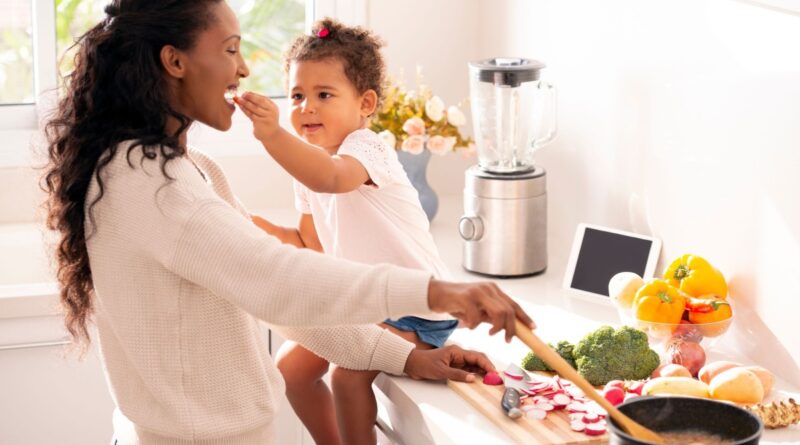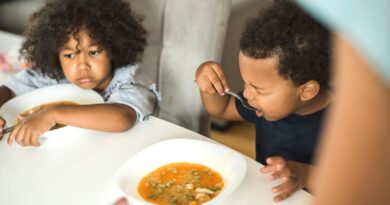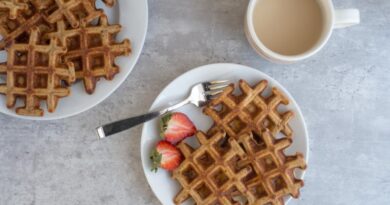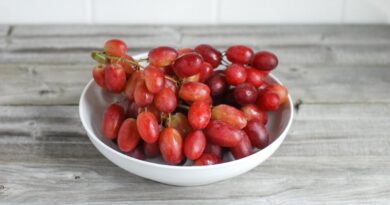How to cook safely when you have a toddler wanting to ‘help’
Our kitchen is where my family all come together.
It’s our social hub where we share a meal, chat about each other’s day, spend important quality time together and where we have lots of fun.
From a very young age my children have ‘helped’ me in the kitchen. I used to be a baker so cakes, cookies, flapjacks were always being made and often had little helpers.
They also enjoyed helping prepare our meals and snacks but let’s face it, having kids in the kitchen isn’t always easy, is it?
In this blog I’m going to take you through the benefits of having kids in the kitchen but most importantly how to do this safely.
This blog contains affiliate links.
Benefits of getting kids involved in the kitchen
There is so much good stuff that comes from having your children ‘help’ in the kitchen, here are a few of the main ones I’ve identified:
Teaching healthy eating in a low pressure environment
Children learn best from watching you as a role model rather than being spoken to about what’s good (or not so good) for them, and it’s a bit of a bugbear of mine that even very young children have a notion of what’s ‘healthy’ or ‘unhealthy’.
Infact, they don’t really understand this, understanding comes during the teenage years.
However children will tell you that an apple is healthy and that sweets are not good for you but they don’t actually understand what this means.
Don’t worry, it’s just a brain development, abstract thought comes later, but my point is that healthy eating chatter falls on deaf ears below the age of 11.
It’s much better to lead by example, showing your child what healthy eating looks like by preparing, cooking and serving these foods more often than their not so healthy equivalents.

Teaching them an important life skill
Over the years I have watched my children learn some really important life skills from being involved in the kitchen. And I was fortunate enough to also pass these on to my patients during my NHS years too.
They learn maths skills earlier from helping weighing foods, measuring liquids and even counting out things like eggs for the cake or the number of potatoes we need to peel.
They learn where food comes from, from snippets of facts that I’ve dropped into our kitchen conversation.
They’ve also learned how food changes as eggs are whipped, sauces are cooked or jelly cools.
They’ve also learned basic food hygiene and food safety as we ‘clean as we go’ (a tip from my old home economics teacher from the early 90’s) and importantly how to clean up spills and messes.
Helping picky eaters improve
This is all about exposure. Whether your child is a typical picky eater or has a more complex feeding problem, exposure to the sensory aspects of food can really help.
Cooking works well because of its extended exposure to foods in an environment where there is no expectation to eat, unlike when food is on their plate!
They will see, interact with, smell, touch and maybe even taste the food without you doing or saying anything. And these 5 sensory steps all need to be mastered before any food becomes a preferred food.

Getting the family fed!
And the most obvious bonus has to link in to the fact that you end up with something to eat at the end of your shared kitchen activities.
At the end of the day we all have to eat 3 meals a day and often a couple of snacks too, so you may as well combine these daily jobs with some quality time with your little ones.
Despite all of these positives, I know plenty of parents who dread having ‘helpers’ in the kitchen. You absolutely have to lower your expectations, food presentation goes out the window and do prepare for mess.
Children are learning, they are developing skills and so their cooking is not as pretty as yours, but mess means that they are getting fully involved with their senses and using their sensory systems is how children interpret and make sense of the world.
Activities even toddlers can do in the kitchen safely
Here are some ideas of activities that children can help you with, while you get dinner on the table!!
Don’t forget to start them off with a cute but protective kids apron. I love this one which can be personalised with their name.
Apple & Cherry Pastry Tarts
For the pastry:
In a large bowl mix together 1 cup (200g) flour, 6tbsp olive or rapeseed oil and 100ml water.
Children can measure out all the ingredients and then get their hands in to bring together into a dough.
Roll out the dough using a child friendly rolling pin.
Stamp out shapes for lids using child safe cookie cutters.
Line a 12 hole muffin tin with the pastry, fill with the fruit filling and top with a pastry shape.
Using a pastry brush, brush the pastry with egg or milk.
For the filling:
Peel 4 large apples, I prefer Pink Ladies for this recipe.
Show your child how to grate the apple using a grater with a container attached so that the grated apple stays contained. Keep an eye and remind them to keep fingers away from the sharp edges and if you are worried you can invest in a pair of protective gloves for them.
De-stone 200g of cherries using a cherry pitter and combine with the grated apple. Add a sprinkle of cinnamon if you like!
Once the tarts are assembled, cook in a preheated oven at 180 degrees for 25-30 minutes.
Fun (or not), the kitchen can also be a dangerous place so here are my top 8 kitchen safety tips for cooking with kids

Top 8 kitchen safety tips for children and toddlers
- Never leave children unattended in the kitchen
Children can do a lot in the kitchen, but not a lot by themselves before they reach secondary school age. Therefore always supervise them.
The dangers of a kitchen aren’t always obvious and situations can change in a second. See section below for kitchen dangers and how to minimise the risks.
- Nothing is more important than safety
If it’s 4.30pm and you’re trying to get dinner on the table for 5pm, it’s likely not going to be the right time for your child to help in the kitchen.
You need to give them time and your full attention if they want to help, so start such activities earlier in the day.
Think of cooking with children as a play activity rather than getting food on the table.
If they are desperate to get involved, they could pour some frozen veg into a bowl, wash salad, or involve them in another way such as setting the table or the very important task of folding napkins!
- Clothing, footwear and long hair
Have you noticed that some clothing has a warning label that says to ‘keep away from flames’?(1)
Most often it’s on children’s fancy dress costumes or pyjamas and it means that these clothes are extremely flammable and not suitable for little helpers to wear in the kitchen or near any naked flame.
Long hair or long baggy sleeves can easily get caught in electric whisks or other kitchen equipment with moving parts, so tie up hair and avoid long sleeves. And no-one likes to find a hair in their meal!
Because of spills, make sure that your children are wearing shoes with non-slip soles. And closed toes are better than open ones just in case heavy, sharp or hot things get dropped.
It goes without saying that it’s likely that there’s going to be splashes of food so consider investing in a kids apron to protect clothes.
- Clean as you go
Important for food hygiene as well as safety. Mop up spills, wipe down worktops and keep your sink filled with warm soapy water so that you can clean as you go and have lots of space for cooking.
Have a damp cloth by the worktop so that it’s in easy reach and collect up any peelings and popping them in the compost or food waste.
Keep the dishwasher door open (if you have one) and pop your finished bowls and utensils straight in – there’s no need to rinse them and actually if you don’t, you are saving water and helping save the planet too!

- Beware of hot pots and pans
You will be the best judge of how close your child can safely be involved with hot pans. This will depend on their maturity and stage of development – it’s not an age bracket rule.
Do make sure the handles of pots and pans face away from the front of the stove so that accidental knocking is avoided. Also it makes them less appealing to a very small child so that they cannot grab hold and pull it down over themselves.
Use an oven mitt or pot holder rather than a tea towel to pick up hot pots as tea towels can dangle through flames posing a fire risk. And make sure that the material is dry, because wet or damp cloth conducts heat and won’t protect you.
Place foods (rather than pour them) into boiling water or hot sauces to prevent splashes.
- Knife safety
Basic knife skills like chopping can be taught to young children from when they have control over holding food in one hand and use a knife in the other, this is usually around 2-3 years of age.
Believe it or not, knives that are sharper are often safer than a blunt knife because they move through the food without resistance whereas a blunt knife needs a fair bit of force.
Teach children the bridge hold for cutting where their hand forms a bridge either side of the food and the knife goes ‘through the tunnel’, this means that fingers are well away from the blade. Here’s a link to the knives I often recommend.
Use a non-slip chopping board and cut the food first so that it’s placed down on its largest flat surface which means it’s unlikely to move around.
Your child will also need to be at a good height so that they can reach the worktop with ease. You may want to invest in a learning tower.
Once you’re finished with a knife be sure to put it somewhere safe and visible – not inside a washing up bowl filled with water and bubbles.
I hope this goes without saying but… no running with knives!
- Practice good food hygiene from the start
Put in place a short routine for getting ready to help out in the kitchen such as washing hands, tying up hair, putting on their apron and talking through the recipe.
Hand washing is really important for food hygiene. Ideally this should be done when you both enter the kitchen, and before and after touching raw food as well as after blowing your nose or coughing or touching a pet.(2)
Let your child know the different colours of chopping boards and what they are used for. This is to prevent cross-contamination of bacteria when you switch between preparing different types of food at one meal such as meat and vegetables.
- Red – Raw meat and poultry
- Blue – Raw fish and shellfish
- Brown – Raw and unwashed fruit, vegetables and salad items
- Green – Washed fruit, vegetables and salad items
- Yellow – Ready to eat and cooked foods
- White – Dairy and bakery
- Purple – Allergen free – you may have a mix of allergies in your home in which case it would be necessary to either use a separate board for each allergen or a shared board that none of the allergens touch.
Afterwards, properly cooling and storing food will help your food last longer and prevent the spread of bacteria or food spoiling.
I have a handy food safety guide that you can pop on your fridge as a reminder.
- Learn basic first aid just in case!
Cooking in the kitchen is fun and such an important learning experience for children but with most things in life it has its risks!
Make sure that you’re prepared by taking a first aid course. Look for one that covers the main kitchen hazards such as this parent first aid course from Daisy First Aid.

Kitchen dangers for young children
This blog wouldn’t be complete without talking about some of the kitchen dangers and what you can do to minimise the risks.
Hopefully it goes without saying that children should never be left unsupervised in the kitchen.
For young children, you’ll need to give clear instructions on what they should and shouldn’t do. For older children, it’s good to explain the reason behind why they are being asked to do something.(3)
Kitchen dangers include:
- Fire and burns – any heat source an be a trigger whether that’s a toaster or your hob,
- Cuts – from knives, grafters, peelers, pizza cutters, anything with sharp parts.
- Slips, trips or falls.
- Equipment with moving parts such as mixers and blenders, turn them off at the mains when not in use.
Fire safety
60% of home fires start in the kitchen so teaching fire safety right from the very start will help your child know how to minimise the risk but also what to do if there is a fire.
Here’s what to do:
- Escape – talk about how you would leave the room if there was a fire. If you or a family member’s clothes have caught alight, just remember “stop, drop, roll”. That phrase has stayed in my head since I was at school!
- Prevention – Always keep an eye on your cooking, never leave food being cooked on the hob unattended. With microwaves never put metal inside as this can start a fire and check packaging as even some plastics can’t go in the microwave. And when you have finished cooking, do a quick check to make sure everything is turned off
- Detection – make sure your house has a working smoke alarm fitted outside the kitchen. You don’t need a fire extinguisher (leave that to the firefighters trained to do this job)
Burns
Burns unfortunately do happen and if you or your little one are unlucky enough to get a burn, here is how the NHS recommend you manage them:
- hold the burn under cool running water for at least 20 minutes.
- If you have cling film, use it to cover the burn to keep it clean, if you don’t have cling film you can use a clean plastic bag.(4)
- If your child is under 10 years old, always take them to the hospital for a burn injury.(4)
It’s an old wives tale about putting butter on a burn, thought to stem from time in the trenches when soldiers needed to keep wounds clean. Butter will take away the sting as it blocks out the air but it also holds the heat in continuing to make the burn worse.
It’s also not sterile and could lead to an infection!

Cuts
If your little one get’s cut with a sharp knife, veggie peeler or kitchen scissors, the first thing to do is to try to stop the bleeding.
Press on the cut with a bandage or a clean cloth such as a tea towel and hold for 10 minutes.
Once the bleeding has stopped you can clean the area by rinsing it with tap water.
You can then clean the area with soap and water. If you have antiseptic you can use this to clean around the area but you try not to get this into the cut.
Once the cut is clean and dry you can cover it with a bandage or a plaster.(5)
Slips, trips and falls
Kitchens can become slippery very quickly if there is water or milk, sauce, oil or any liquid involved in your cooking. After all, if you don’t get messy you’re not doing it properly!!
Prevention of falls is always better than treating them so where you can try to mop up spills as soon as possible.
If your little one falls, they are likely to be a bit shocked and might cry.
But if they don’t hurt and haven’t hit their head, it’s okay to get them up slowly, just like you would if they tripped in the playground.
If your child gets a hard bump on the head be sure to comfort them first. Find a cold compress such as a bag of frozen peas wrapped in a tea towel or a compress from a first aid kit and hold this to their bump.
Most bumps won’t need any more than a cold compress but if they seem dazed, confused, pass out or even if you are just not sure, it’s always best to get them checked for concussion.(6)

Equipment with moving parts
Kitchen equipment with moving parts such as mixers and blenders can be a danger for little fingers or long hair.
Turn them off at the mains when not in use, so inquisitive little people don’t press the buttons accidentally turning them on.
If you’ve enjoyed what you’ve learned here then I’d like to introduce you to the Happy Healthy Eaters Club. This is a members-only club where you’ll learn how to raise a child who skips to the table (without you having to ask 50 times first), sits down, and happily munches away.
The club will teach you all about food and parenting techniques so that you can nip fussy eating in the bud (or prevent it before it begins) and make you’ll feel safe in the knowledge your child has eaten their nutrients, that they’ll sleep well, grow healthy bones and brains, and not pick up all those bugs.
Your parenting around food means that your little one will learn to be excited to try new foods, family mealtimes are a breeze and there’s not a reward, bribe, or iPad insight and you haven’t spent hours in the kitchen cooking up different meals for everyone either. And I promise you… you’ll no longer be scraping rejected food from the floor! Here’s the link to learn more: https://www.thechildrensnutritionist.com/hhec-open

The post How to cook safely when you have a toddler wanting to ‘help’ appeared first on The Children's Nutritionist.




